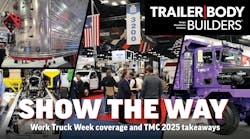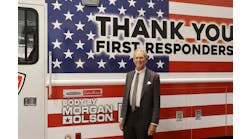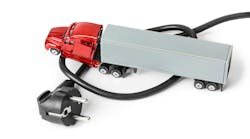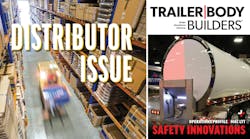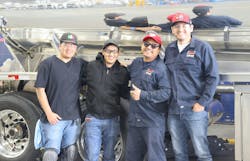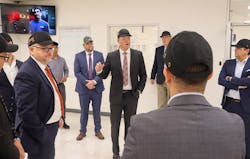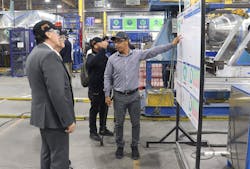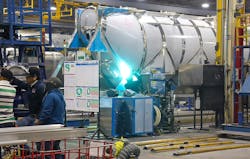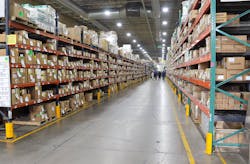CIUDAD JUÁREZ, Mexico—Engineered Transportation International equipment brands include storied tank trailer manufacturers Heil Trailer and Polar Tank Trailer, which combine to capture nearly 50% of the tank trailer market in North America. And EnTrans’ most prolific plant is its Juarez Trailer Operations (JTO) in Mexico, just across the border from El Paso, Texas, where Heil and Polar can cover 40% of the tank trailer industry’s total annualized demand, according to EnTrans CEO Ryan Rockafellow.
It’s also one of the most efficient facilities in the 43-company portfolio of private-equity owner American Industrial Partners, he adds with pride.
“Over the last two years, when AIP brings in interns and new hires and wants to show them what good looks like, they bring them to this facility,” Rockafellow told Mexican officials and other special guests Feb. 27 during the unveiling of a vintage tank wagon and tour of the “maquila” opened here 10 years ago. “It’s the people in this plant, the lean OpEx activities here, and the quality.”
More specifically, facility leaders’ access to skilled laborers; dedication to effective, flexible operations and continuous improvement; and consistent production quality—combined with Heil and Polar’s comprehensive tank trailer lineup and telematics innovations—have transformed JTO into the most prolific tank trailer plant in North America, turning out roughly 2,700 liquid and dry bulk tankers last year.
“And we still have an opportunity to really turn things up,” he told Trailer-Body Builders' sister publication, Bulk Transporter, in an exclusive interview.
The flagship facility provides a competitive advantage no one can match—and EnTrans, its blue-chip fleet customers, and the city of Juarez all share in the rewards, leaders maintain. EnTrans’ five-brand portfolio is now a booming business (with tank trailers products generating nearly three-fourths of total revenue), bulk haulers benefit from a responsive partner who’s able to meet their specialized specs, and about 900 employees enjoy life-changing pay and perks inside a safety-minded environment.
“It’s impressive to see how quickly they can respond to customer issues, concerns, or feedback, and distill that implementation down to an actual running production change,” said Jon Sarrazin, president of Quest Liner and Foodliner Mexico, who travelled here to discuss his team’s equipment needs and tour the facility. “They strike the right balance between running a large-scale production operation to support the tank truck industry with the appropriate amount of customization to meet the unique requirements of individual customers.”
Tank trailer titan
Heil is the oldest tank trailer brand in the U.S. Julius Heil founded the business as Heil Rail Joint Welding in 1901 in Milwaukee. Polar formed in 1946, giving the combined operations more than 200 years of tank trailer manufacturing experience. AIP purchased Heil from Dover in late 2011 and formed EnTrans in 2014, the same year it acquired Jarco and opened the Juarez facility. AIP bought Polar and Jarco in 2015, merged EnTrans and Polar in 2017, and divested Polar Service Centers to Quala in 2022.
Heavy-haul trailer maker Kalyn Siebert, originally a division of Heil based in Gatesville, Texas, rounds out EnTrans’ brands (J&L Tank still is a Heil sub-brand). Jarco builds LPG bobtails in Salem, Illinois; and Serva provides oil and gas equipment out of Tulsa, Oklahoma; and Calgary, Alberta, Canada.
Heil and Polar operate three North American factories in Juarez; Athens, Tennessee; and Holdingford, Minnesota; which combine to produce a full line of aluminum and stainless-steel tank trailers. Aluminum trailers for refined petroleum products account for about a quarter of EnTrans sales; and stainless steel chemical trailers, dry bulkers, aluminum asphalt and crude oil trailers, and stainless food-grade tankers combine for close to 50%. “What makes EnTrans, and Heil and Polar, unique is, unlike our competition, if there is a tank trailer to be sold for a product vertical, we build it,” Rockafellow said. “It’s in our portfolio, ensuring we withstand the headwinds in any market segment.”
Athens, with the capacity to produce 2,400 trailers per year, builds only aluminum tankers; Holdingford, with a capacity of 1,500 trailers per year, primarily makes stainless steel tankers; and Juarez, with a 3,600-trailer capacity, builds every trailer, helping EnTrans executives establish JTO as an indispensable manufacturing enterprise, both within its own business and the Mexican economy.
With help from John Snodgrass, vice president of international business, EnTrans supplied the Mexican government with 50 aluminum tanks built for an overseas market within three weeks of officials’ decision to phase out carbon steel trailers after a deadly explosion in 2019. And a key customer helped them stay open during pandemic lockdowns by convincing local authorities EnTrans was a critical supplier when many other Juarez companies ceased operations deemed non-essential.
Read more: Tale of the tank: EnTrans revitalizes vintage vehicle
“They are doing a great job,” said Sergio Colín, president of the manufacturer’s association in Juarez, who attended the unveiling and tour. “And with the market we have today, they still have a lot of opportunity to grow here. Why? Because in all the border crossings from Brownsville [Texas] to San Diego, the commercial transactions between Mexico and the U.S. involve a lot of raw materials that are transported in these tanks.”
Flagship facility
The 400,000-sq.-ft. Juarez plant sits on a 20-acre lot. It includes offices, shared spaces, a spacious cafeteria, and a cavernous production floor with 11 manufacturing lines and floor-to-ceiling shelves filled with myriad tank trailer parts and components. Lines 1-6 are for aluminum trailers, and Lines 7, 8, 11, 12, and 14 produce stainless-steel tankers. JTO previously used Lines 9 and 10 to build carbon steel barrels, work EnTrans now sends to Arrow Tank and Engineering in Cambridge, Minnesota, to make room for additional stainless steel production.
Heil and Polar trailers are built on “flex lines” regularly reconfigured for new trailers. “We have to adapt to the changing marketplace,” said Randy Arlt, EnTrans senior vice president and JTO general manager. “If you stay static, you shrink.”
Adaptability also allows the plant to manage smaller production runs compared to orders placed by large dry van fleets. “It’s abnormal for us to get a run of 100 of anything,” Arlt explained. “It’s often one, three, or five units, and we can better respond to those changes with flexible cells.”
A dedicated team utilizes software and detailed measurements of all equipment, down to the fixtures, shelves, and carts, to improve processes and model new layouts operators recreate on the production floor. “With Lines 12 and 14, we only need three days to install the whole line,” said Carlos Ivan, JTO director of continuous improvement. The facility runs a lean manufacturing program that encourages employee collaboration and certification advancement, and continuous improvement efforts include regular “Kaizen” meetings for attacking challenges, and incorporating dealer and customer input. “That helps us reduce our warranty percent of sales,” Arlt said. “It was over 2% and now it’s less than half a percent.”
Arlt “near-sources” materials wherever possible, and EnTrans’ industrial supplier, Fastenal, sources parts locally, he said. Finished trailers are shipped to a PSC yard in New Horizon, Texas, just outside El Paso, where dealers and customers receive them. Direct sales to fleet customers account for approximately 50% of sales, with the other 50% sold through EnTrans’ network of 45-plus dealers spread across the U.S., Canada, and Latin America.
“There’s no one else like us in this business,” EnTrans CCO Jake Radish noted. “And the transformational efforts taking place at this facility, the build quality, and the quality of labor we’re able to secure in this market, are unmatched.”
Colín agrees, saying companies like EnTrans also are transforming Juarez’s overall reputation.
“I’m very proud that the companies producing products in Juarez are creating finished goods, because in the past we executed a lot of manual operations without finished goods, only parts that were shipped out, maybe to the U.S. or another country, where somebody else put everything together and created the finished good,” he said. “And today, we’re seeing finished goods here—and that is beautiful.”
Game-changing production
As Arlt walked the plant floor during the tour, he greeted employees by name and took time to shake hands and pose for pictures. And every fabricator, welder, and shop supervisor shared one thing—the smiles on their faces. “People here truly aspire to a better life,” Arlt said. “We’re blessed in the United States, and they have a lot going for them here, but they work very hard to improve their circumstances.
“[And] these jobs will bring people into the middle class—and even better for some.”
JTO jobs also come with two meals a day, transportation to and from work, and safety-focused management. The facility earned plant safety awards from the Truck Trailer Manufacturers Association in three of the last five years. Leaders also host annual family days for employees, their loved ones, and local officials, firefighters, and police that can draw up to 3,000 attendees, Arlt shared. “It’s personal,” Radish added.
“We want to make sure that our employees’ livelihood is elevated to the next echelon.”
Juarez boasts 320 manufacturers that employ 316,000 workers, Colín said. JTO lifts up nearly 900 people, while also creating indirect jobs for Mexican suppliers, service providers, and contractors, he pointed out. And EnTrans could easily add 100 new workers if it needed to quickly boost production, Arlt said. “The deep labor pool in this region, and the access we have to skilled workers, who we put through our own training programs, gives us an advantage our competitors can’t match,” Rockafellow said.
Personalization extends to how EnTrans identifies orders on the line—always by name, not serial numbers, which promotes buy-in, Arlt maintained—and its commitment to incorporating operator input into enhancements. “Our people produce these trailers,” Ivan said. “Not the managers, not the directors—the people. And if they don’t work well, then we can’t deliver our products.”
Competitive advantage
JTO benefits extend beyond the lives of employees, delivering advantages for EnTrans and its customers. “This Juarez plant allows us to compete within every tank trailer space and go after every customer within each of these groups,” Radish said, pointing out EnTrans serves eight different aluminum and stainless-steel tank trailer segments and now is adding cryogenic and liquid hydrogen tankers.
The plant currently makes 50% of all EnTrans trailers, Arlt said.
“The tank trailer side of our business truly is the core part of our business,” Rockafellow confirmed.
The range of trailer equipment coming out of the facility also allows EnTrans to serve large customers with diverse trailer fleets.
Read more: 2024 Outlook: How ‘not that bad’ will it be?
“Between our two brands, Foodliner and Quest Liner, we run a variety of trailers—aluminum, stainless, dry bulk, and liquid in many configurations,” Sarrazin said. “And if you think about it from a supply chain perspective, our customers are the ones who dictate to us what type of equipment is required for a load, based on product, and loading and unloading requirements, and that works its way back up the supply chain to our trailer manufacturers. So if we’re going to be a carrier that meets the value proposition we drive to the market, we need a manufacturing partner that can do the same for us.”
They also need a partner who can supply trailers quickly, and JTO is delivering there, too.
“We’ve really caught up to the demand,” Arlt said. “The last two years, bookings were ahead of builds, and that was true for the industry. But right now we’re building at the booking rate, or slightly ahead.”
Inventive expansion
With the largest and lowest-cost tank trailer manufacturing operation leading the way, EnTrans companies are generating more than twice the revenue they produced when AIP purchased Heil in 2011, and it’s still growing by replacing diminished demand for crude oil and sand trailers with more specialized tankers for fuel, DEF, and asphalt. “We’re still building crude trailers but nowhere near the level that we were 10 years ago,” Rockafellow said. “Yet we’re the biggest we’ve ever been and producing more than we ever have out of this facility because we’ve been able to diversify this plant.”
Key growth areas include new military contracts, hydrogen delivery solutions, smart-trailer telematics, and Kalyn Siebert’s heavy-haul equipment. EnTrans is also growing and diversifying its international presence with Snodgrass’ help. Heil has a plant in Thailand that serves local and export markets, and EnTrans maintains licensing and supply agreements in Argentina and Australia. “The goal over the next three years is continued growth,” Radish confirmed.
EnTrans’ intelligent tank system, TANK Ai, already is taking off, he added, with close to 300 orders from key customers on the books. “We’re excited with where that’s heading, and it’s taking more of a diverse element than we originally expected,” Radish said. “We thought it’d be more tailored toward the petroleum side. But we’ve got chemical guys coming to the table, and carriers on the dry bulk side.”
Key customers also are exploring the liquid hydrogen space today, Rockafellow said.
“We look at that as being a good growth opportunity for us,” he said. “We’re probably still years away from hydrogen really presenting a viable need to be transported. But when it becomes a viable on-highway fuel—meaning it’s actually powering cars or trucks—that’s really when the tanker side will come in, and that’s arguably three to five years away. But we want to get in on the front end of that.”
